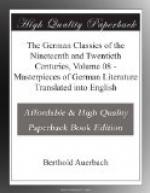There is certainly a wonderful charm in conjuring up the spirit of past ages from yellowed sheets of music, and, with the help of historical study, in quiet cozy hours, to tune one’s own ear anew, so that it may once more hear in spirit the harmonies which were listened to by generations long since deceased, just as they sounded to the ear of the latter. There is a wonderful charm in searching after the most secret instinctive tones of the emotional life of a bygone world, the natural sounds of their souls, which are so entirely different from our own and which would be lost for us—since picture and word stand too far off—had they not found fixed expression in musical composition. The character-picture of the last century, as portrayed by the historian of culture, is lacking in that peculiar soulful lustre, that mysterious little luminous point which shines upon the beholder from the eye of a well-painted portrait, if such things as the knowledge of the eye for natural scenery and the ear for music of the age are not included among the features of the character-picture.
THE STRUGGLE OF THE ROCOCO WITH THE PIGTAIL[17]
By W.H. RIEHL
Translated by FRANCES H. KING
No time is so rich as the seventeenth and eighteenth centuries in humorous original types of a distinct genre, who built for themselves a world apart. Everywhere in this period we meet with eccentrics by profession, who with deliberate intention play, as the actors say, a “charged” character-part. Their freaks and gambols were considered worthy to be handed on to posterity in memoirs and books of anecdote, and whoever wanted to be a gentleman was obliged, in some particulars at least, to be a fool. The romantic adventures of the Middle Ages returned again in a new costume, in less fantastic but far more humorous forms; Don Quixote exchanged his helmet for a wig.
For the nineteenth century original types of this kind—where they still happen to exist—are quite adventitious; for the seventeenth and eighteenth centuries they were essential.
That capricious glorying in the most baroque personality possible, that leaning toward individual caricature, inborn in the whole age, agrees indeed very well with the arbitrarily fantastic taste of the Rococo period—of the seventeenth century—but it stands in sharpest contrast to the tendency of the Pigtail in the eighteenth. For to prune down the natural growth, to sober down the fantastic, to make the luxurious poor, emaciated, and uniform, and to weave life, art, and science on the same loom of academic rule—all this is a characteristic which distinguishes the Pigtail from the Rococo. This leaning toward individual caricature nevertheless was maintained throughout the entire age of the Pigtail. Indeed the very figure in the escutcheon of this period, the pigtail of hair, grew out of the contradictory effort to restrain and render uniform the natural luxuriance of the hair, and yet at the same time to append to men’s backs a pure freak, a little, absolutely original scroll.




